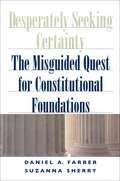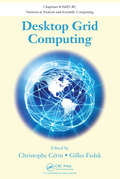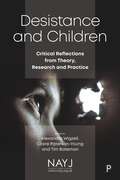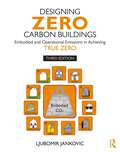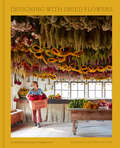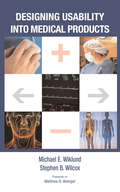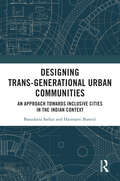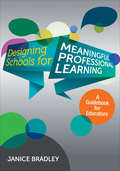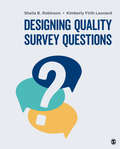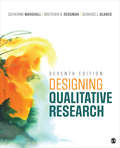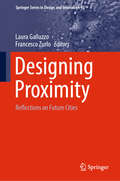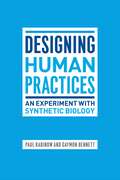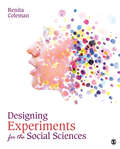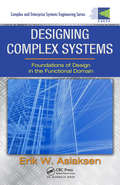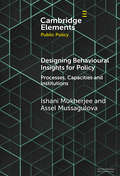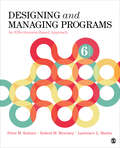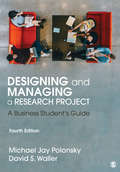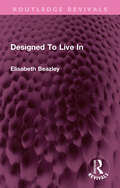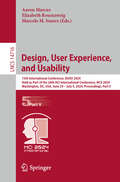- Table View
- List View
Desperately Seeking Certainty: The Misguided Quest for Constitutional Foundations
by Daniel A. Farber Suzanna SherryIrreverent, provocative, and engaging, Desperately Seeking Certainty attacks the current legal vogue for grand unified theories of constitutional interpretation. On both the Right and the Left, prominent legal scholars are attempting to build all of constitutional law from a single foundational idea. Dan Farber and Suzanna Sherry find that in the end no single, all-encompassing theory can successfully guide judges or provide definitive or even sensible answers to every constitutional question. Their book brilliantly reveals how problematic foundationalism is and shows how the pragmatic, multifaceted common law methods already used by the Court provide a far better means of reaching sound decisions and controlling judicial discretion than do any of the grand theories.
Desktop Grid Computing
by Christophe Cérin Gilles FedakDesktop Grid Computing presents common techniques used in numerous models, algorithms, and tools developed during the last decade to implement desktop grid computing. These techniques enable the solution of many important sub-problems for middleware design, including scheduling, data management, security, load balancing, result certification, and f
Desistance and Children: Critical Reflections from Theory, Research and Practice
by Colin Falconer John Wainwright Julie Shaw Martin Stephenson Claire Fitzpatrick Neal Hazel Stephen Case Samantha Burns Jo Staines Kathy Hampson Gilly Sharpe Steve Carr Kirstine Szifris Diana Johns Kevin R Haines Ross Little Katie Hunter Tim Rosier Sean Creaney Andrew Brierley Anne-Marie Douglas Roberta Evans Neema Trivedi-BatemanAvailable open access digitally under CC BY-NC-ND licence. ‘Desistance’ - understanding how people move away from offending – has become a significant policy focus in recent years, with desistance thinking transplanted from the adult to the youth justice system in England and Wales. This book is the first to critique this approach to justice-involved children, many of whom are yet to fully develop an identity (criminal or otherwise) from which to ‘desist’. Featuring voices from academia, policy and practice, this book explores practical approaches to desistance with children in the ‘Child First’ context. It gives new insights into how children can be supported to move away from offending and proposes reforms to make a meaningful difference to children’s lives.
Designing Zero Carbon Buildings: Embodied and Operational Emissions in Achieving True Zero
by Ljubomir JankovicIn this significantly revised third edition, Designing Zero Carbon Buildings combines embodied and operational emissions into a structured approach for achieving zero emissions by a specific year with certainty.Simulation and quantitative methods are introduced in parallel with analogue scale models to demonstrate how things work in buildings. Where equations are provided, this is also explained with common analogue objects, pictures, and narratives. A Zero Equation introduced in this book is not only explained as an equation but also as an analogy with a jam jar and spoons, making the book accessible for a range of audiences. Tasks for simple experiments, exercises, discussion questions, and summaries of design principles are provided in closing lines of chapters.This book introduces new case studies, in addition to an updated case study of the Birmingham Zero Carbon House, applying embodied and operational emissions to assess their status using the Zero Equation. The approach introduced brings about a sense of realism into what true zero emissions mean. Written for students, educators, architects, engineers, modellers, practising designers, sustainability consultants, and others, it is a major positive step towards design thinking that makes achieving zero carbon emissions a reality.
Designing with Dried Flowers: Creating Everlasting Arrangements
by Hannah Rose MullerStep into the world of beautiful, everlasting flowers with this book of thirty-two dried flower arrangements that can be made all year round.Flowers are often fleetingly lovely, but a dried bouquet is a gift that can last. In Designing with Dried Flowers, you&’ll find small arrangements for every day, beautiful wreaths for every season and occasion, and celebration showstoppers that will look gorgeous in the moment and for months to come. Farmer-florist Hannah Muller of The Wreath Room at Full Belly Farm shares her unique methods to naturally dry flowers that hold their color and delicacy. Alongside the arrangements you&’ll learn how to dry your own flowers, whether they&’re from the supermarket or your garden. From there, create one of the many unique arrangements in the book, and easily create new ones with the same flowers. With step-by-step instructions for every arrangement, gorgeous photography to inspire your creations, and helpful information along the way, Designing with Dried Flowers is a must-have for every flower lover.
Designing Usability into Medical Products
by Michael E. Wiklund Stephen B. WilcoxAdvocating a user-centered approach to medical technology design, Designing Usability into Medical Products covers the essential processes and specific techniques necessary to produce safe, effective, usable, and appealing medical systems and products. Written by experts on user-centered research, design, and evaluation, the book provides a range o
Designing Trans-Generational Urban Communities: An Approach towards Inclusive Cities in the Indian Context
by Basudatta Sarkar Haimanti BanerjiThis book examines the inclusiveness of city planning and design to address gaps in policies, strategies and design guidelines for developing trans-generational urban communities in India. Identifying key factors and measurable indicators of trans-generational cities within social, physical, and economic dimensions, the volume highlights the need for establishing age-friendly and child-friendly cities and communities. Through a systematic process of ground data collection, the book explores issues related to health, daily routine, lifestyle, recreation, and socialization within vulnerable groups, considering their physical and cognitive limitations for framing adaptable policies. The volume integrates a bottom-up and top-down approach by integrating the needs and perception of the target group obtained from extensive groundwork with the available theories and literature in allied fields adopting a step-by step synchronized methodology. It also presents the way forward for framing policies focusing on socio-economic security, participation, dignity, care, and self-fulfillment.Offering rich empirical research, this book will be useful for students, teachers and researchers of architecture, urban design, urban geography, urban studies, urban development and planning, and child psychology. It will also be of interest to urban planners and designers, policy planners, local government authorities and professionals engaged in the discipline.
Designing Schools for Meaningful Professional Learning: A Guidebook for Educators
by Janice T. BradleyEmpower your teachers as partners in professional learning—and see student achievement soar! Are you ready for a professional learning program that makes a lasting difference in the quality of teaching within your school or district? Janice Bradley, a highly-respected educator shows how to promote your faculty’s professional growth and accountability through job-embedded learning. This breakthrough book enables education leaders to Work collaboratively with faculty to develop and implement a five-part plan for professional learning designed to meet your school’s unique needs Connect professional learning with practices that have the greatest positive effect in the classroom Link professional development to teacher evaluation in a manner that builds trust Learn best practices from schools that implemented Bradley’s methodology, and benefit from user-friendly strategies and tools Say goodbye to top-down programming that’s quickly forgotten, and discover an approach that empowers and inspires your faculty at all levels of experience. "It′s hard to imagine a simple, five-step process that could integrate all of Learning Forward′s seven professional learning standards, yet that is exactly what Janice Bradley has done in the book, Designing Schools for Meaningful Professional Learning." —Patricia Roy, Senior Consultant Learning Forward Center for Results "I’ve never experienced professional learning such as this! Taking part in collaborative learning with my team gave me the opportunity to explore questions and curiosities about my students that have been buried in years of district-driven professional development. Now my colleagues and I research together in order to create a learning environment every child deserves." —Kathryn Million, First-Grade Dual Language Teacher Las Cruces, NM
Designing Schools for Meaningful Professional Learning: A Guidebook for Educators
by Janice T. BradleyEmpower your teachers as partners in professional learning—and see student achievement soar! Are you ready for a professional learning program that makes a lasting difference in the quality of teaching within your school or district? Janice Bradley, a highly-respected educator shows how to promote your faculty’s professional growth and accountability through job-embedded learning. This breakthrough book enables education leaders to Work collaboratively with faculty to develop and implement a five-part plan for professional learning designed to meet your school’s unique needs Connect professional learning with practices that have the greatest positive effect in the classroom Link professional development to teacher evaluation in a manner that builds trust Learn best practices from schools that implemented Bradley’s methodology, and benefit from user-friendly strategies and tools Say goodbye to top-down programming that’s quickly forgotten, and discover an approach that empowers and inspires your faculty at all levels of experience. "It′s hard to imagine a simple, five-step process that could integrate all of Learning Forward′s seven professional learning standards, yet that is exactly what Janice Bradley has done in the book, Designing Schools for Meaningful Professional Learning." —Patricia Roy, Senior Consultant Learning Forward Center for Results "I’ve never experienced professional learning such as this! Taking part in collaborative learning with my team gave me the opportunity to explore questions and curiosities about my students that have been buried in years of district-driven professional development. Now my colleagues and I research together in order to create a learning environment every child deserves." —Kathryn Million, First-Grade Dual Language Teacher Las Cruces, NM
Designing Quality Survey Questions
by Kimberly Firth Leonard Sheila B. RobinsonSurveys are a cornerstone of social and behavioral research, and with the use of web-based tools, surveys have become an easy and inexpensive means of gathering data. But how researchers ask a question can dramatically influence the answers they receive. Designing Quality Survey Questions shows readers how to craft high quality, precisely-worded survey questions that will elicit rich, nuanced, and ultimately useful data to help answer their research or evaluation questions. The authors address challenges such as language preferences for standard demographic questions (e.g. How to ask about gender), creative question design to keep respondents engaged and avoid survey fatigue, web-based survey formats, culturally-responsive survey design, and factors that influence survey responses (memory, social desirability, etc.). Numerous examples of questions illustrate each identified principle of question construction.
Designing Quality Survey Questions
by Kimberly Firth Leonard Sheila B. RobinsonSurveys are a cornerstone of social and behavioral research, and with the use of web-based tools, surveys have become an easy and inexpensive means of gathering data. But how researchers ask a question can dramatically influence the answers they receive. Designing Quality Survey Questions shows readers how to craft high quality, precisely-worded survey questions that will elicit rich, nuanced, and ultimately useful data to help answer their research or evaluation questions. The authors address challenges such as language preferences for standard demographic questions (e.g. How to ask about gender), creative question design to keep respondents engaged and avoid survey fatigue, web-based survey formats, culturally-responsive survey design, and factors that influence survey responses (memory, social desirability, etc.). Numerous examples of questions illustrate each identified principle of question construction.
Designing Qualitative Research
by Catherine Marshall Gretchen B Rossman Gerardo BlancoOffering clear, easy-to-understand guidance on designing qualitative research, this fully updated Seventh Edition of Marshall and Rossman’s bestselling text retains the useful examples, tools, and vignettes that makes it such an outstanding resource. The book takes students from selecting a research genre through building a conceptual framework, data collection and interpretation, and arguing the merits of the proposal. Now featuring a new co-author, Gerardo L. Blanco, this edition includes more on the history and new emerging genres of qualitative inquiry, as well as a more sustained and deeper focus on social media and other digital applications in conducting qualitative research. New application activities provide opportunities for students to try out ideas, while timely vignettes illustrate the methodological challenges posed by the intellectual, ethical, political, and technological advances affecting society. PowerPoints to accompany this text are available on an instructor site.
Designing Qualitative Research
by Catherine Marshall Gretchen B Rossman Gerardo BlancoOffering clear, easy-to-understand guidance on designing qualitative research, this fully updated Seventh Edition of Marshall and Rossman’s bestselling text retains the useful examples, tools, and vignettes that makes it such an outstanding resource. The book takes students from selecting a research genre through building a conceptual framework, data collection and interpretation, and arguing the merits of the proposal. Now featuring a new co-author, Gerardo L. Blanco, this edition includes more on the history and new emerging genres of qualitative inquiry, as well as a more sustained and deeper focus on social media and other digital applications in conducting qualitative research. New application activities provide opportunities for students to try out ideas, while timely vignettes illustrate the methodological challenges posed by the intellectual, ethical, political, and technological advances affecting society. PowerPoints to accompany this text are available on an instructor site.
Designing Proximity: Reflections on Future Cities (Springer Series in Design and Innovation #45)
by Francesco Zurlo Laura GalluzzoThis book showcases nine possible scenarios for future cities, based on different aspects and characteristics of the term "proximity". Different points of view have been investigated on many themes related to the city of proximities: from bottom-up design actions to the inclusive city, from neighborhood services to public space in transformation, to platforms and economies of proximity. When discussing the concept of proximity, it is imperative to several aspects of building and inhabiting the city of fifteen minutes. The city and its neighborhoods are complex structures, made up of stratified levels of evolving systems, that encompass administrative and political aspects, urban spatial considerations, the dynamics of human interaction, and more. The necessity to re-appropriate the urban space leads all inhabitants to contemplate different aspects of their lives concerning proximity space, reflecting on how behavior, actions, and relationships can be improved and transformed to make our future more sustainable. This book envisions future scenarios that will make public space an active and functional place for the city, more inclusive, responding to the needs and desires of the different populations that inhabit it.
Designing Human Practices: An Experiment with Synthetic Biology
by Paul Rabinow Gaymon BennettIn 2006 anthropologists Paul Rabinow and Gaymon Bennett set out to rethink the role that human sciences play in biological research, creating the Human Practices division of the Synthetic Biology Engineering Research Center—a facility established to create design standards for the engineering of new enzymes, genetic circuits, cells, and other biological entities—to formulate a new approach to the ethical, security, and philosophical considerations of controversial biological work. They sought not simply to act as watchdogs but to integrate the biosciences with their own discipline in a more fundamentally interdependent way, inventing a new, dynamic, and experimental anthropology that they could bring to bear on the center’s biological research.Designing Human Practices is a detailed account of this anthropological experiment and, ultimately, its rejection. It provides new insights into the possibilities and limitations of collaboration, and diagnoses the micro-politics which effectively constrained the potential for mutual scientific flourishing. Synthesizing multiple disciplines, including biology, genetics, anthropology, and philosophy, alongside a thorough examination of funding entities such as the National Science Foundation, Designing Human Practices pushes the social study of science into new and provocative territory, utilizing a real-world experience as a springboard for timely reflections on how the human and life sciences can and should transform each other.
Designing Experiments for the Social Sciences: How to Plan, Create, and Execute Research Using Experiments
by Renita Coleman"This book is a must for learning about the experimental design–from forming a research question to interpreting the results this text covers it all." –Sarah El Sayed, University of Texas at Arlington Designing Experiments for the Social Sciences: How to Plan, Create, and Execute Research Using Experiments is a practical, applied text for courses in experimental design. The text assumes that students have just a basic knowledge of the scientific method, and no statistics background is required. With its focus on how to effectively design experiments, rather than how to analyze them, the book concentrates on the stage where researchers are making decisions about procedural aspects of the experiment before interventions and treatments are given. Renita Coleman walks readers step-by-step on how to plan and execute experiments from the beginning by discussing choosing and collecting a sample, creating the stimuli and questionnaire, doing a manipulation check or pre-test, analyzing the data, and understanding and interpreting the results. Guidelines for deciding which elements are best used in the creation of a particular kind of experiment are also given. This title offers rich pedagogy, ethical considerations, and examples pertinent to all social science disciplines.
Designing Experiments for the Social Sciences: How to Plan, Create, and Execute Research Using Experiments
by Renita Coleman"This book is a must for learning about the experimental design–from forming a research question to interpreting the results this text covers it all." –Sarah El Sayed, University of Texas at Arlington Designing Experiments for the Social Sciences: How to Plan, Create, and Execute Research Using Experiments is a practical, applied text for courses in experimental design. The text assumes that students have just a basic knowledge of the scientific method, and no statistics background is required. With its focus on how to effectively design experiments, rather than how to analyze them, the book concentrates on the stage where researchers are making decisions about procedural aspects of the experiment before interventions and treatments are given. Renita Coleman walks readers step-by-step on how to plan and execute experiments from the beginning by discussing choosing and collecting a sample, creating the stimuli and questionnaire, doing a manipulation check or pre-test, analyzing the data, and understanding and interpreting the results. Guidelines for deciding which elements are best used in the creation of a particular kind of experiment are also given. This title offers rich pedagogy, ethical considerations, and examples pertinent to all social science disciplines.
Designing Complex Systems: Foundations of Design in the Functional Domain (Complex and Enterprise Systems Engineering)
by Erik W. AslaksenWithout standardized construction elements such as nuts, bolts, bearings, beams, resistors and the like, the design of physical equipment is hopelessly inefficient, and engineers are continually bogged down with re-designing these elements over and over again. Emphasizing a top-down approach, this volume considers the purpose and basic features of design and how the concept of value can provide a quantitative measure of that wider interaction of the engineered object with its environment. This work also develops the domain in which functional design takes place and explores how the system concept can be embedded in that domain. It proposes a number of functional design elements and develops them in considerable detail, outlining how they can be applied as part of a coherent design framework. For greater understanding of the discussed concepts, numerous examples and analogies are included.
Designing Behavioural Insights for Policy: Processes, Capacities & Institutions (Elements in Public Policy)
by null Ishani Mukherjee null Assel MussagulovaThe diversity of knowledge surrounding behavioural insights (BI) means in the policy sciences, although visible, remains under-theorized with scant comparative and generalizable explorations of the procedural prerequisites for their effective design, both as stand-alone tools and as part of dedicated policy 'toolkits'. While comparative analyses of the content of BI tools has proliferated, the knowledge gap about the procedural needs of BI policy design is growing recognizably, as the range of BI responses grows in practice necessitating specific capabilities, processes and institutional frameworks to be in place for their design. This Element draws on the literature on policy design and innovation adoption to explore the administrative, institutional and capacity endowments of governments for the successful and appropriate integration of BI in existing policy frameworks. Further, we present three illustrative cases with respect to their experience of essential procedural endowments facilitating for the effective integration of BI in policy design.
Designing and Managing Programs: An Effectiveness-Based Approach
by Peter M. Kettner Lawrence L. Martin Robert M. MoroneyThis classic text for social work and human services helps readers grasp the meaning and significance of measuring performance and evaluating outcomes. Hands-on and practical, Designing and Managing Programs incorporates the principles of effectiveness-based planning as it addresses the steps of designing, implementing, and evaluating a human services program at the local agency level. Written by leaders in the field, it guides students through the process from beginning to end. Meaningful examples—from problem analysis and needs assessment to evaluating effectiveness and calculating costs—enhance reader understanding of how concepts are implemented in the real world. The Sixth Edition contains new examples and references, and updates based on changes to federal regulations. An instructor website includes essay questions, PowerPoint slides, and suggested assignments designed by the authors.
Designing and Managing Programs: An Effectiveness-Based Approach
by Peter M. Kettner Lawrence L. Martin Robert M. MoroneyThis classic text for social work and human services helps readers grasp the meaning and significance of measuring performance and evaluating outcomes. Hands-on and practical, Designing and Managing Programs incorporates the principles of effectiveness-based planning as it addresses the steps of designing, implementing, and evaluating a human services program at the local agency level. Written by leaders in the field, it guides students through the process from beginning to end. Meaningful examples—from problem analysis and needs assessment to evaluating effectiveness and calculating costs—enhance reader understanding of how concepts are implemented in the real world. The Sixth Edition contains new examples and references, and updates based on changes to federal regulations. An instructor website includes essay questions, PowerPoint slides, and suggested assignments designed by the authors.
Designing and Managing a Research Project: A Business Student′s Guide
by Michael J. Polonsky David S. WallerDesigning and Managing a Research Project: A Business Student’s Guide is a practical, step-by-step guide that shows business students how to successfully conduct a research project, from choosing the topic to presenting the results. The authors have applied their many years of experience in supervising student projects to provide examples of actual research problems and to offer practical solutions. The inclusion of topics such as supervision, group work and ethics, and both qualitative and quantitative data analysis, along with examples from real student research provide a unique perspective. The new Fourth Edition includes broader types of student project examples, such as an Economics thesis, additional international business cases, increased coverage of Questionnaire Design and Institutional Review Boards, and an integrated case throughout the book on "High Performance Shoes" with supporting materials and data. Additional resources including case studies, PowerPoint slides, and test bank are available on the authors’ website.
Designing and Managing a Research Project: A Business Student′s Guide
by Michael J. Polonsky David S. WallerDesigning and Managing a Research Project: A Business Student’s Guide is a practical, step-by-step guide that shows business students how to successfully conduct a research project, from choosing the topic to presenting the results. The authors have applied their many years of experience in supervising student projects to provide examples of actual research problems and to offer practical solutions. The inclusion of topics such as supervision, group work and ethics, and both qualitative and quantitative data analysis, along with examples from real student research provide a unique perspective. The new Fourth Edition includes broader types of student project examples, such as an Economics thesis, additional international business cases, increased coverage of Questionnaire Design and Institutional Review Boards, and an integrated case throughout the book on "High Performance Shoes" with supporting materials and data. Additional resources including case studies, PowerPoint slides, and test bank are available on the authors’ website.
Designed To Live In (Routledge Revivals)
by Elisabeth BeazleyOriginally published in 1962, this book traces the main influences behind modern design in domestic architecture. It does so against the context of the effect each new dwelling has on its environment and the effect its design has on those in the surrounding (and often older, historic) housing stock. Diverse influences such as the bye-law street and Le Corbusier’s Ville Radieuse are discussed, while the ideas bearing on the individual private house range from those of the early nineteenth century villa builders to Frank Lloyd Wright’s prairie houses and the work of Mies van der Rohe. The book closes with a detailed discussion of the problems and possibilities of domestic design in house-building in the late 20th Century
Design, User Experience, and Usability: 13th International Conference, DUXU 2024, Held as Part of the 26th HCI International Conference, HCII 2024, Washington, DC, USA, June 29 – July 4, 2024, Proceedings, Part V (Lecture Notes in Computer Science #14716)
by Aaron Marcus Marcelo M. Soares Elizabeth RosenzweigThis five-volume set LNCS 14712-14716 constitutes the refereed proceedings of the 13th International Conference on Design, User Experience, and Usability, DUXU 2024, held as part of the 26th International Conference, HCI International 2024, in Washington, DC, USA, during June 29 – July 4, 2024. The total of 1271 papers and 309 posters included in the HCII 2024 proceedings was carefully reviewed and selected from 5108 submissions. The DUXU 2024 proceedings were organized in the following topical sections: Part I: Information Visualization and Interaction Design; Usability Testing and User Experience Evaluation. Part II: Designing Interactions for Intelligent Environments; Automotive Interactions and Smart Mobility Solutions; Speculative Design and Creativity. Part III: User Experience Design for Inclusion and Diversity; Human-Centered Design for Social Impact. Part IV: Designing Immersive Experiences across Contexts; Technology, Design, and Learner Engagement; User Experience in Tangible and Intangible Cultural Heritage. Part V: Innovative Design for Enhanced User Experience; Innovations in Product and Service Design.
